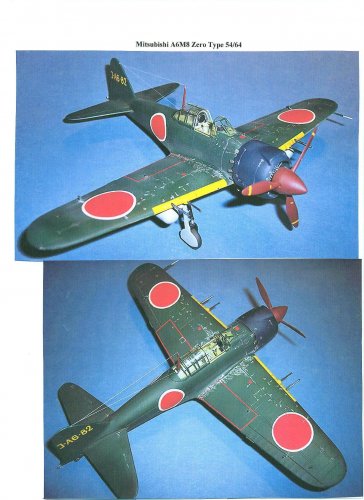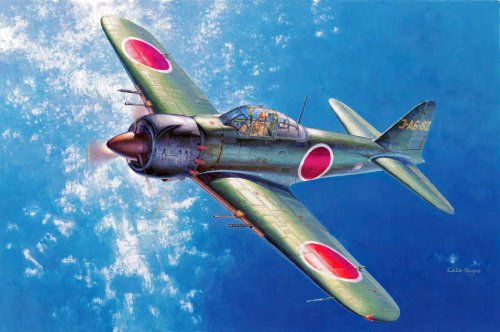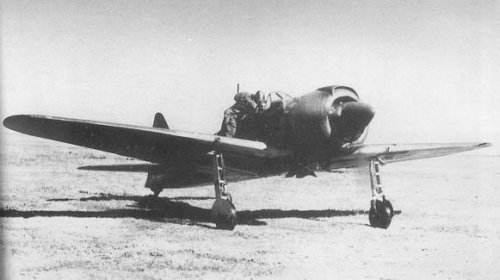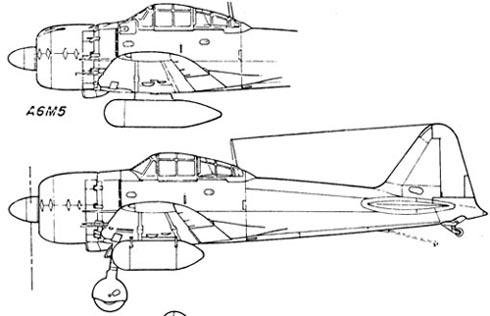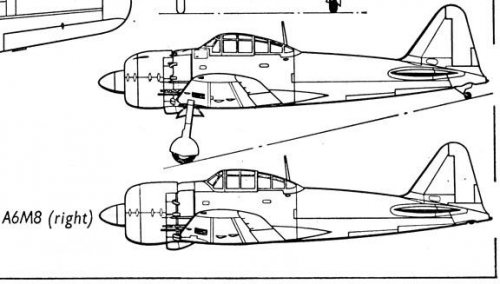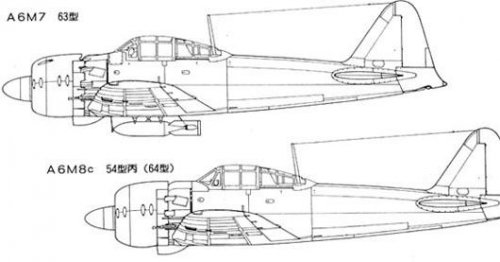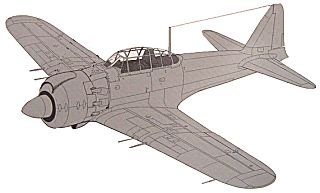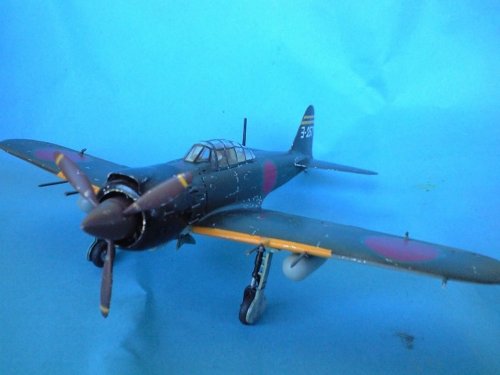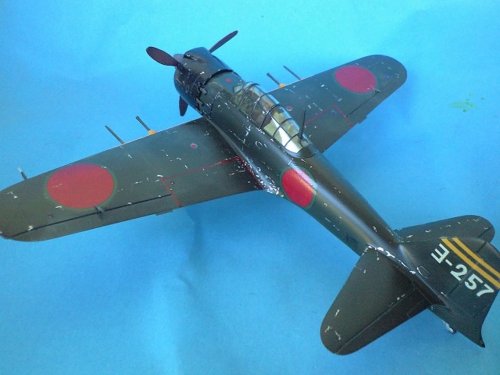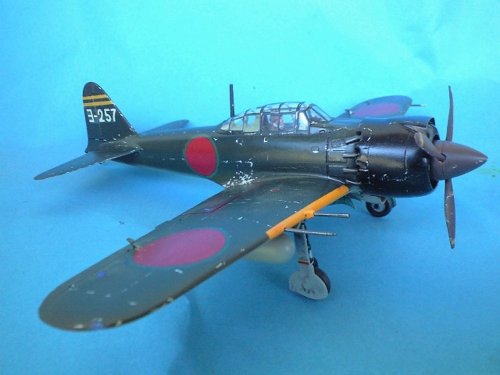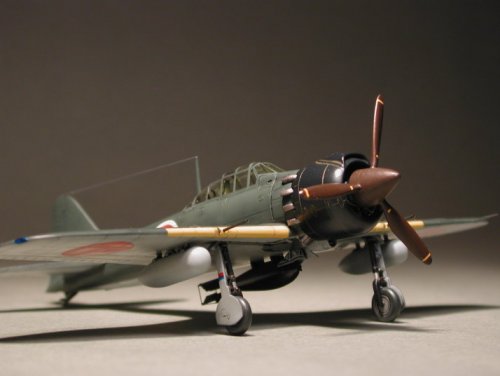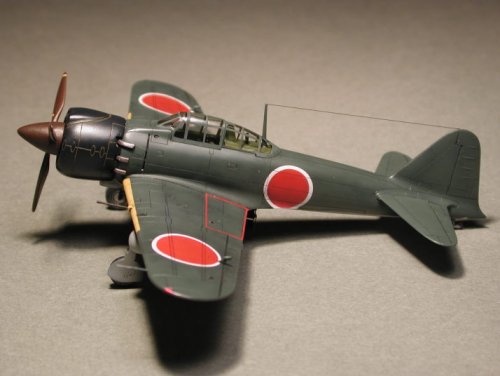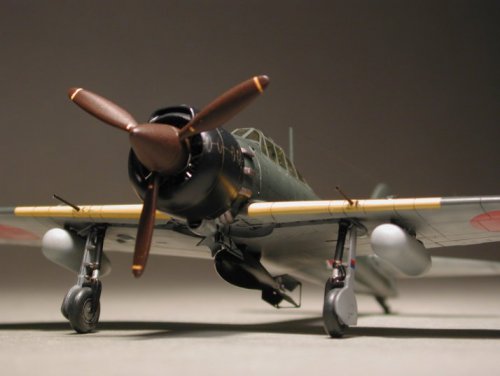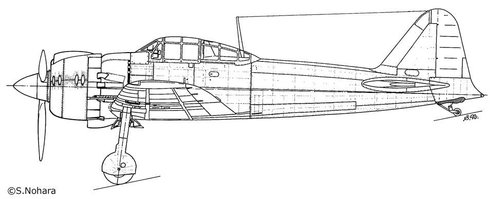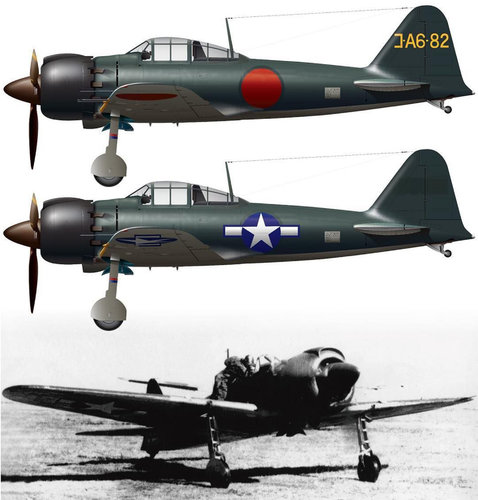You are using an out of date browser. It may not display this or other websites correctly.
You should upgrade or use an alternative browser.
You should upgrade or use an alternative browser.
Mitsubishi A6M8 Type 54/64
- Thread starter Justo Miranda
- Start date
windswords
ACCESS: Secret
- Joined
- 19 May 2009
- Messages
- 389
- Reaction score
- 218
The A6M8 was the last variant of the Zero created but did not see production. It did not have the Nakajima Sakae engine. Instead it had a Mitsubishi Kinsei 62 engine with 1,560 hp (1,164 kW) up from the previous enigine's 1130 hp. The plane is recognizable from the larger carburetor intake and larger spinner. The cowling changes necessitated the removal of the fuselage mounted 13mm gun leaving the two 20 mm and two 13 mm guns in the wing. Two prototypes were built but no production ramp up was possible because the war ended.
Attachments
- Joined
- 8 March 2009
- Messages
- 1,057
- Reaction score
- 1,299
I posted the "infamous" photo of the a6m8, along with some drawing, here; http://www.secretprojects.co.uk/forum/index.php?topic=661.120
But Jim Long of j-aircraft seems to be convinced that this is a hoax, and that the aircraft did not need a carburetor scoop as shown in the photo and drawings.
I have no info on the origins or anything else on the Japanese drawings posted in the above thread. Hopefully someone here can translate.
But Jim Long of j-aircraft seems to be convinced that this is a hoax, and that the aircraft did not need a carburetor scoop as shown in the photo and drawings.
I have no info on the origins or anything else on the Japanese drawings posted in the above thread. Hopefully someone here can translate.
windswords
ACCESS: Secret
- Joined
- 19 May 2009
- Messages
- 389
- Reaction score
- 218
Sienar,
Do you have a link to the j-aircraft thread? If Mr Long says it's a hoax, did he mean that the photo was altered in some way?
Do you have a link to the j-aircraft thread? If Mr Long says it's a hoax, did he mean that the photo was altered in some way?
- Joined
- 8 March 2009
- Messages
- 1,057
- Reaction score
- 1,299
I afraid that thread has been long lost due to several purges of the forums. It may exist in an archived form.. but its been ages since I posted there.
From what I remember though, the thread was around 2004 and stirred up a big debate as to whether or not the photo was a fake. Long took the position of it being a fake, and supported it by saying that an intake like shown in the photo was unnecessary for the type of engine fitted.
EDIT: oops. Forgot to mention that many people thought the photo was a forgery. I tried to track down the photo since the alleged photographer is known, but I found nothing but a dead end. Again that was back in 2004, maybe someone could find something now. I'll have to look through some old hard drives for more info tomorrow.
From what I remember though, the thread was around 2004 and stirred up a big debate as to whether or not the photo was a fake. Long took the position of it being a fake, and supported it by saying that an intake like shown in the photo was unnecessary for the type of engine fitted.
EDIT: oops. Forgot to mention that many people thought the photo was a forgery. I tried to track down the photo since the alleged photographer is known, but I found nothing but a dead end. Again that was back in 2004, maybe someone could find something now. I'll have to look through some old hard drives for more info tomorrow.
Thanks 
Apteryx
ACCESS: Confidential
- Joined
- 28 September 2007
- Messages
- 157
- Reaction score
- 48
I remember that tempest in a teapot over on J-Aircraft. There's only one (to my knowledge) extant photo of the A6M8, and it only turned up a few years ago. There are a couple of versions, however, and the one I attach here has had the background masked out with rubylith film--it's more apparent on larger versions of the photo. Removing the background on photos was frequently done in the last century, often just to clean up the image and emphasize the subject. The hard edge surrounding the plane where the film had been cut away with an exacto knife seems to have aroused suspicions of tampering, and there followed an increasingly vehement discussion about the apparent angle of the cowling, lighting, the grassy knoll and so on. Basically it seems that some people don't like the way that cowling looks and so dismiss it as phony. My feeling is that the kludgy look of the cowling is itself evidence for the authenticity of the photo. If someone had actually gone to the trouble of dummying up an A6M8, they would have done something more in line with the existing drawings, all of which are likely to be guesses, but which vaguely agree.
Attachments
Apteryx
ACCESS: Confidential
- Joined
- 28 September 2007
- Messages
- 157
- Reaction score
- 48
A follow-up on my last post--herewith are small scans of the profile drawings I'd seen depicting the A6M8 cowling prior to the appearance of that photo ten years or so back. From William Green's Famous Fighters, Rene Francillon's Japanese AC of the Pacific War, and the Japanese FAOW volume on the late Zero-sen versions.
They all depict a cowling similar in shape and layout to the A6M5 cowling--just a bit "inflated." This is what people had been expecting the real thing to look like.
They all depict a cowling similar in shape and layout to the A6M5 cowling--just a bit "inflated." This is what people had been expecting the real thing to look like.
Attachments
blackkite
Don't laugh, don't cry, don't even curse, but.....
- Joined
- 31 May 2007
- Messages
- 8,821
- Reaction score
- 7,721
Attachments
blackkite
Don't laugh, don't cry, don't even curse, but.....
- Joined
- 31 May 2007
- Messages
- 8,821
- Reaction score
- 7,721
Attachments
windswords
ACCESS: Secret
- Joined
- 19 May 2009
- Messages
- 389
- Reaction score
- 218
Apteryx said:... and there followed an increasingly vehement discussion about the apparent angle of the cowling, lighting, the grassy knoll and so on...
He he I see what you did there... ;D
blackkite
Don't laugh, don't cry, don't even curse, but.....
- Joined
- 31 May 2007
- Messages
- 8,821
- Reaction score
- 7,721
Zero Fighter Type 54 / Type 64 (A6M8)
The Zero Fighter Type 54 / Type 64 was a type in which the engine of the Zero Fighter Type 52 Hei was replaced with a Mitsubishi-made Kinsei(Venus) 62 type engine (take off power 1,560hp) with a water methanol injection device.
The Zero Fighter 54 type was the prototype model, and the Zero Fighter 64 type was the model number attached to the mass production aircraft.
The 13.2mm machine gun at the nose removed to install the Kinsei(Venus) engine, which had a larger diameter than the Sakae engine.
The Type 64, like the Type 62 / Type 63, was premised on the operation as a fighter bomber (special attack aircraft), but there was a strong demand as a pure fighter.
This model of Zero Fighter regained its original movement performance by this engine replacement, but the prototype was completed in April 1945 (Showa 20), just before the end of the war. In addition, the production line of the Venus 62 type engine was destroyed by the air raid by the US military, so the two completed Zero Fighter 54 type prototypes reached the end of the war during the test flight.
The Zero Fighter Type 64, which was ordered to be produced from July 1945, reached the end of the war during production. It should be noted that, for a long time, no material for the Zero Fighter 54 type has been confirmed, and the shape of the nose remains a mystery, but in recent years photographs and drawings have been discovered.
According to this photo, the spinner and propeller are equipped with the same type of Suisei bomber type 33 with the same type engine. This model became the final model of Zero Fighter.
The Zero Fighter Type 54 / Type 64 was a type in which the engine of the Zero Fighter Type 52 Hei was replaced with a Mitsubishi-made Kinsei(Venus) 62 type engine (take off power 1,560hp) with a water methanol injection device.
The Zero Fighter 54 type was the prototype model, and the Zero Fighter 64 type was the model number attached to the mass production aircraft.
The 13.2mm machine gun at the nose removed to install the Kinsei(Venus) engine, which had a larger diameter than the Sakae engine.
The Type 64, like the Type 62 / Type 63, was premised on the operation as a fighter bomber (special attack aircraft), but there was a strong demand as a pure fighter.
This model of Zero Fighter regained its original movement performance by this engine replacement, but the prototype was completed in April 1945 (Showa 20), just before the end of the war. In addition, the production line of the Venus 62 type engine was destroyed by the air raid by the US military, so the two completed Zero Fighter 54 type prototypes reached the end of the war during the test flight.
The Zero Fighter Type 64, which was ordered to be produced from July 1945, reached the end of the war during production. It should be noted that, for a long time, no material for the Zero Fighter 54 type has been confirmed, and the shape of the nose remains a mystery, but in recent years photographs and drawings have been discovered.
According to this photo, the spinner and propeller are equipped with the same type of Suisei bomber type 33 with the same type engine. This model became the final model of Zero Fighter.
blackkite
Don't laugh, don't cry, don't even curse, but.....
- Joined
- 31 May 2007
- Messages
- 8,821
- Reaction score
- 7,721
https://hobbycom.jp/workshop/library/zero/10.html
Zero-type fighter Type 54 (A6M8)
Width: 11m
Total length: 9.121m
Total height: 3.57m
Weight: 2,150kg
Total weight: 3,150kg
Top speed: 563km/h
Time to altitude:6 minutes 50 seconds to altitude 6,000m
Engine: Mitsubishi "Kinsei" 62 air-cooled double star type 14-cylinder (1,500 hp)
Ceiling: 10,780m
Range: 30 minutes + 850km
Armed: 20mm cannon×2, 13mm machine gun×2, 1× 250kg bomb under the fuselage, 2×60kg bombs under the wing or 4×30kg bombs under the wing
Zero-type fighter Type 54 (A6M8)
Width: 11m
Total length: 9.121m
Total height: 3.57m
Weight: 2,150kg
Total weight: 3,150kg
Top speed: 563km/h
Time to altitude:6 minutes 50 seconds to altitude 6,000m
Engine: Mitsubishi "Kinsei" 62 air-cooled double star type 14-cylinder (1,500 hp)
Ceiling: 10,780m
Range: 30 minutes + 850km
Armed: 20mm cannon×2, 13mm machine gun×2, 1× 250kg bomb under the fuselage, 2×60kg bombs under the wing or 4×30kg bombs under the wing
Attachments
So it would have similar performance to the Ki100.Zero Fighter Type 54 / Type 64 (A6M8)
The Zero Fighter Type 54 / Type 64 was a type in which the engine of the Zero Fighter Type 52 Hei was replaced with a Mitsubishi-made Kinsei(Venus) 62 type engine (take off power 1,560hp) with a water methanol injection device.
The Zero Fighter 54 type was the prototype model, and the Zero Fighter 64 type was the model number attached to the mass production aircraft.
The 13.2mm machine gun at the nose removed to install the Kinsei(Venus) engine, which had a larger diameter than the Sakae engine.
The Type 64, like the Type 62 / Type 63, was premised on the operation as a fighter bomber (special attack aircraft), but there was a strong demand as a pure fighter.
This model of Zero Fighter regained its original movement performance by this engine replacement, but the prototype was completed in April 1945 (Showa 20), just before the end of the war. In addition, the production line of the Venus 62 type engine was destroyed by the air raid by the US military, so the two completed Zero Fighter 54 type prototypes reached the end of the war during the test flight.
The Zero Fighter Type 64, which was ordered to be produced from July 1945, reached the end of the war during production. It should be noted that, for a long time, no material for the Zero Fighter 54 type has been confirmed, and the shape of the nose remains a mystery, but in recent years photographs and drawings have been discovered.
According to this photo, the spinner and propeller are equipped with the same type of Suisei bomber type 33 with the same type engine. This model became the final model of Zero Fighter.
Similar threads
-
A6M8 Zero with a Homare engine rather than Kinsei
- Started by Hardrada55
- Replies: 2
-
-
-
-


